Pigmentary Disorders 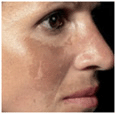
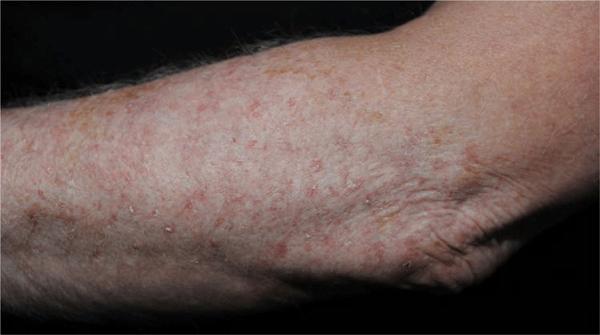
Figure 13-1. This image demonstrates the protective role of melanin. It shows the hypomelanotic lower arm of a patient with piebaldism (a very rare genetic syndrome which is caused by mutations of the KIT protooncogene and results in a developmental patchy loss of melanocytes and thus in depigmented patches of skin) that exhibits dermatoheliosis including multiple solar (actinic) keratoses, whereas the normally pigmented upper arm is devoid of these lesions.
Epidemiology
Sex. Equal in both sexes. The predominance in women suggested by the literature likely reflects the greater concern of women about cosmetic appearance.
Age of Onset. May begin at any age, but in 50% of cases it begins between the ages of 10 and 30 years.
Incidence. Common, worldwide. Affects up to 1% of the population.
Race. All races. The apparently increased prevalence reported in some countries and among darker-skinned persons results from a dramatic contrast between white vitiligo macules and dark skin and from marked social stigma in countries such as India.
Inheritance. Vitiligo has a genetic background; >30% of affected individuals have reported vitiligo in a parent, sibling, or child. Vitiligo in identical twins has been reported. Transmission is most likely polygenic with variable expression. The risk of vitiligo for children of affected individuals is unknown but may be <10%. Individuals from families with an increased prevalence of thyroid disease, diabetes mellitus, and vitiligo appear to be at increased risk for development of vitiligo.
Pathogenesis
Three principal theories have been presented about the mechanism of destruction of melanocytes in vitiligo:
1. The autoimmune theory holds that selected melanocytes are destroyed by certain lymphocytes that have somehow been activated.
2. The neurogenic hypothesis is based on an interaction of the melanocytes and nerve cells.
3. The self-destruct hypothesis suggests that melanocytes are destroyed by toxic substances formed as part of normal melanin biosynthesis.
Clinical Manifestation
Many patients attribute the onset of their vitiligo to physical trauma (where vitiligo appears at the site of trauma—Koebner phenomenon), illness, or emotional stress. Onset after the death of a relative or after severe physical injury is often mentioned. A sunburn reaction may precipitate vitiligo.
Skin Lesions. Macules, 5 mm to 5 cm or more in diameter (Figs. 13-2 and 13-3). “Chalk” or pale white, sharply marginated. The disease progresses by gradual enlargement of the old macules or by development of new ones. Margins are convex. Trichrome vitiligo (three colors: white, light brown, dark brown) represents different stages in the evolution of vitiligo. Pigmentation around a hair follicle in a white macule represents residual pigmentation or return of pigmentation (Fig. 13-3).
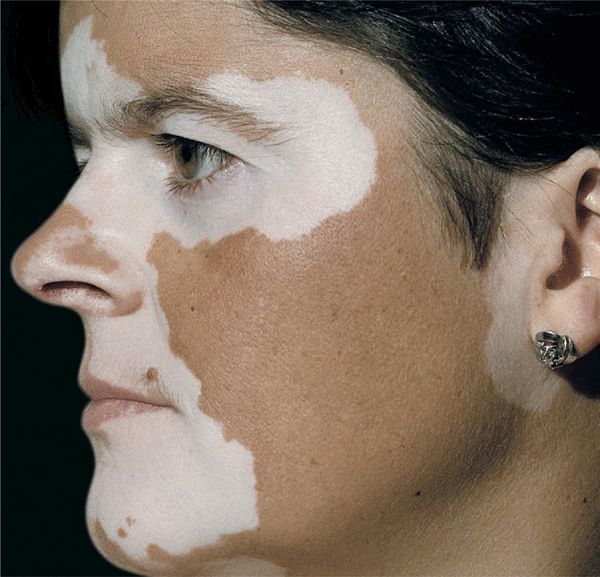
Figure 13-2. Vitiligo: face Extensive depigmentation of the central face. Involved vitiliginous skin has convex borders, extending into the normal pigmented skin. Note the chalk-white color and sharp margination. Note also that the dermal nevomelanocytic nevus on the upper lip has retained its pigmentation.
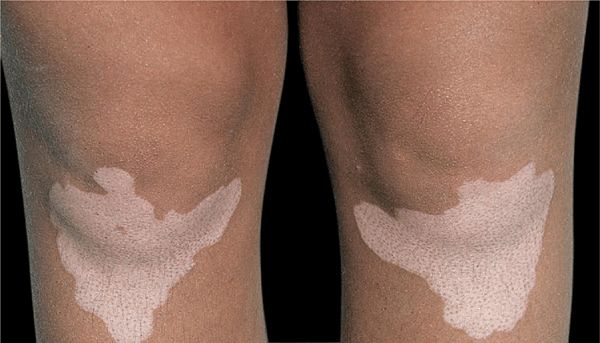
Figure 13-3. Vitiligo: knees Depigmented, sharply demarcated macules on the knees. Apart from the loss of pigment, vitiliginous skin appears normal. There is striking symmetry. Note tiny follicular pigmented spots within the vitiligo areas that represent repigmentation.
Distribution. Two general patterns. The focal type is characterized by one or several macules in a single site; this may be an early evolutionary stage of one of the other types in some cases. Generalized vitiligo is more common and is characterized by widespread distribution of depigmented macules, often in a remarkable symmetry (Fig. 13-3). Typical macules occur around the eyes (Fig. 13-2) and mouth and on digits, elbows, and knees, as well as on the low back and in genital areas (Fig. 13-4). The “lip-tip” pattern involves the skin around the mouth as well as on distal fingers and toes; lips, nipples, genitalia, and anus may be involved. Confluence of vitiligo results in large white areas, and extensive generalized vitiligo may leave only a few normally pigmented areas of skin—vitiligo universalis (Fig. 13-5).
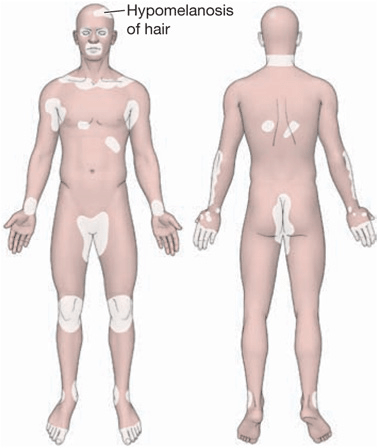
Figure 13-4. Vitiligo: predilection sites
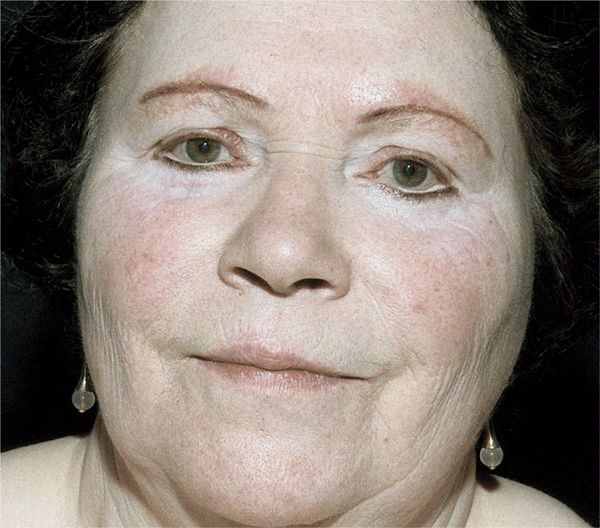
Figure 13-5. Universal vitiligo Vitiliginous macules have coalesced to involve all skin sites with complete depigmentation of skin and hair in a female. The patient is wearing a black wig and has darkened the brows with eyebrow pencil and eyelid margins with eye liner.
Segmental Vitiligo. This is a special subset that usually develops in one unilateral region; usually does not extend beyond that initial onesided region (though not always); and, once present, is very stable. May be associated with vitiligo elsewhere.
Associated Cutaneous Findings. White hair and prematurely gray hair. Circumscribed areas of white hair, analogous to vitiligo macules, are called poliosis. Alopecia areata (see Section 33) and halo nevi (see Section 9). In older patients, photoaging as well as solar keratoses may occur in vitiligo macules in those with history of long exposures to sunlight. Squamous cell carcinoma, limited to the white macules, has rarely been reported.
General Examination. Rarely associated with thyroid disease, Hashimoto thyroiditis (Graves disease); also diabetes mellitus—probably <5%; pernicious anemia (uncommon, but increased risk); Addison disease (very uncommon); and multiple endocrinopathy syndrome (rare). Ophthalmologic examination may reveal evidence of healed chorioretinitis or iritis. Vision is unaffected. Hearing is normal. The Vogt-Koyanagi-Harada syndrome is vitiligo + poliosis + uveitis + dysacusis + alopecia areata.
Laboratory Examinations
Wood Lamp Examination. For identification of vitiligo macules in very light skin.
Dermatopathology. In certain difficult cases, a skin biopsy may be required. Vitiligo macules show normal skin except for an absence of melanocytes.
Electron Microscopy Absence of melanocytes and of melanosomes in keratinocytes.
Laboratory Studies. Thyroxine (T4), thyroid-stimulating hormone (radioimmunoassay), fasting blood glucose, complete blood count with indices (pernicious anemia), ACTH stimulation test for Addison disease, if suspected.
Diagnosis
Normally, diagnosis of vitiligo can be made readily on clinical examination of a patient with progressive, acquired, chalk-white, bilateral (usually symmetric), sharply defined macules in typical sites.
Differential Diagnosis of Vitiligo
• Pityriasis alba (slight scaling, fuzzy margins, off-white color) (see Fig. 13-18).
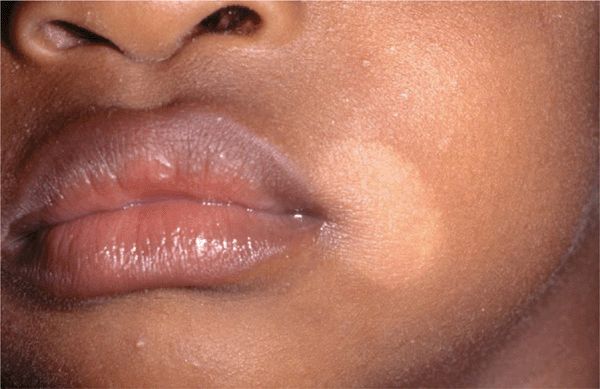
Figure 13-18. Pityriasis alba A common disfiguring hypomelanosis, which, as the name indicates, is a white area (alba) with very mild scaling (pityriasis). It is observed in a large number of children in the summer in temperate climates. It is mostly a cosmetic problem in persons with brown or black skin and commonly occurs on the face, as in this child. Among 200 patients with pityriasis alba, 90% ranged from 6 to 12 years of age. In young adults, PA quite often occurs on the arms and trunk.
• Pityriasis versicolor alba (fine scales with greenish-yellow fluorescence under Wood lamp, positive KOH (see Fig. 13-15).

Figure 13-15. Pityriasis versicolor (A) Hypopigmented, sharply marginated, scaling macules on the back of an individual with skin phototype III. Gentle abrasion of the surface will accentuate the scaling. This type of hypomelanosis can remain long after the eruption has been treated and the primary process is resolved. (B) Pityriasis versicolor in African skin Lesions are perifollicular on the chest and coalesce to large confluent patches on the neck where the fine scaling can best be seen.
• Leprosy (endemic areas, off-white color, usually ill-defined anesthetic macules).
• Postinflammatory leukoderma (off-white macules; usually a history of psoriasis or eczema in the same macular area, see Fig. 13-16).
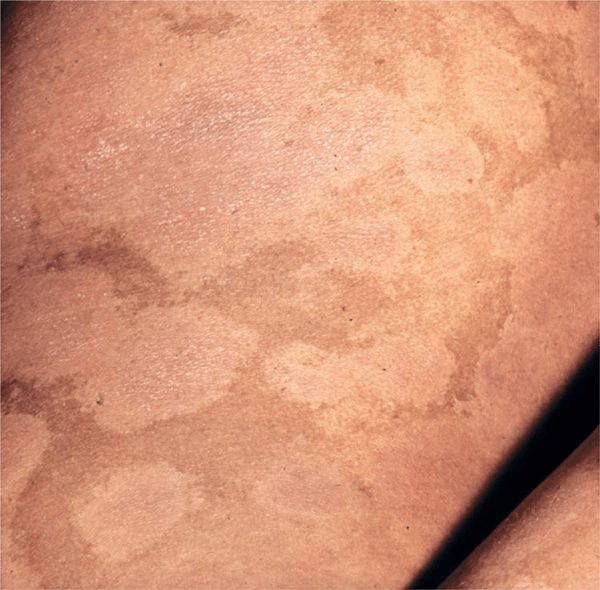
Figure 13-16. Postinflammatory hypomelanosis (psoriasis) The hypomelanotic lesions correspond exactly to the antecedent eruption. There is some residual psoriasis within the lesions.
• Mycosis fungoides (may be confusing as only depigmentation may be present and biopsy is necessary) (see Section 21).
• Chemical leukoderma (history of exposure to certain phenolic germicides). This is a difficult differential diagnosis, as melanocytes are absent as in vitiligo.
• Nevus anemicus (does not enhance with Wood lamp; does not show erythema after rubbing).
• Nevus depigmentosus (stable, congenital, off-white macules, unilateral).
• Hypomelanosis of Ito (bilateral, Blaschko lines, marble cake pattern; 60–75% have systemic involvement—central nervous system, eyes, musculoskeletal system).
• Tuberous sclerosis (stable, congenital off-white macules polygonal, ash-leaf shape, occasional segmental macules, and confetti macules) (see Section 16).
• Leukoderma associated with melanoma (may not be true vitiligo inasmuch as melanocytes, although reduced, are usually present).
• Vogt-Koyanagi-Harada syndrome (vision problems, photophobia, bilateral dysacusis).
• Waardenburg syndrome (commonest cause of congenital deafness, white macules and white forelock, iris heterochromia).
• Piebaldism (congenital, white forelock, stable, dorsal pigmented stripe on back, distinctive pattern with large hyperpigmented macules in the center of the hypomelanotic areas) (see Fig. 13-1).
Course and Prognosis
Vitiligo is a chronic disease. The course is highly variable, but rapid onset followed by a period of stability or slow progression is most characteristic. Up to 30% of patients may report some spontaneous repigmentation in a few areas—particularly areas that are exposed to the sun. Rapidly progressive, or “galloping,” vitiligo may quickly lead to extensive depigmentation with a total loss of pigment in skin and hair, but not eyes.
The treatment of vitiligo-associated disease (i.e., thyroid disease) has no impact on the course of vitiligo.
Management
The approaches to the management of vitiligo are as follows:
Sunscreens
The dual objectives of sunscreens are protection of involved skin from acute sunburn reaction and limitation of tanning of normally pigmented skin.
Cosmetic Coverup
The objective of coverup with dyes or makeup is to hide the white macules so that the vitiligo is not apparent.
Repigmentation
The objective of repigmentation (Figs. 13-6 and 13-7) is the permanent return of normal melanin pigmentation.
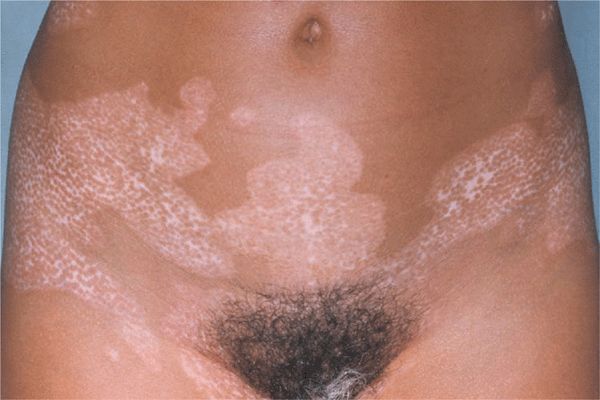
Figure 13-6. Vitiligo repigmentation A follicular pattern of repigmentation due to PUVA therapy occurring in a large vitiliginous macule on the lower abdomen. By confluence of the macules, the vitiliginous areas have almost filled in but are still lighter than the surrounding normal skin. Melanocytes may persist in the hair follicle epithelium and serve to repopulate involved skin, spontaneously or with photochemotherapy.

Figure 13-7. Vitiligo: therapy-induced repigmentation This 20-year-old Indian female is being treated with photochemotherapy (PUVA). There is slight erythema in the vitiliginous macules in the early phases (left) of therapy that will be followed by follicular pigmentation as in Fig. 13-6; after 1 year of treatment, vitiligo has completely repigmented, but there is now hyperpigmentation of the knees (right). This, however, will fade with time and the color of the repigmented areas will blend with that of the surrounding skin.
Localized Macules
• Topical glucocorticoids: Monitor for signs of early steroid atrophy.
• Topical calcineurin inhibitors: Tacrolimus and pimecrolimus. They are reported to be most effective when combined with UVB or excimer laser therapy.
• Topical photochemotherapy [topical 8-methoxypsoralen (8-MOP) and UVA]
• Excimer laser (308 nm) Best results in the face.
Generalized Vitiligo
• Systemic photochemotherapy: Oral PUVA may be done using sunlight (in summer or in areas with year-round sunlight) and 5-methoxypsoralen (5-MOP) (available in Europe) or with artificial UVA and either 5-MOP or 8-MOP. Is up to 85% effective in >70% of patients with vitiligo of the head, neck, upper arms and legs, and trunk (Figs. 13-6 and 13-7). However, at least 1 year of treatment is required to achieve this result. Distal hands and feet and the “lip-tip” variant of vitiligo are poorly responsive.
• Narrow-band UVB, 311 nm: This is just as effective as PUVA and does not require psoralens. It is the treatment of choice in children <6 years of age.
Note: Response to all treatments is slow. When it occurs, it is signaled by tiny, usually follicular macules of pigmentation (Fig. 13-6).
Minigrafting
Minigrafting (autologous Thiersch grafts, suction blister grafts, autologous mini-punch grafts, transplantation of cultured autologous melanocytes) may be a useful technique for refractory and stable segmental vitiligo macules. “Pebbling” of the grafted site may occur.
Depigmentation
The objective of depigmentation is “one” skin color in patients with extensive vitiligo or in those who have failed or reject other treatments.
Treatments. Bleaching of normally pigmented skin with monobenzylether of hydroquinone 20% (MEH) cream is a permanent, irreversible process. The success rate is >90%. The end-stage color of depigmentation with MEH is chalk-white, as in vitiligo macules.
 Normal skin color is composed of a mixture of four biochromes, namely, (1) reduced hemoglobin (blue), (2) oxyhemoglobin (red), (3) carotenoids (yellow; exogenous from diet), and (4) melanin (brown).
Normal skin color is composed of a mixture of four biochromes, namely, (1) reduced hemoglobin (blue), (2) oxyhemoglobin (red), (3) carotenoids (yellow; exogenous from diet), and (4) melanin (brown). The principal determinant of the skin color is melanin pigment, and variations in the amount and distribution of melanin in the skin are the basis of the three principal human skin colors: black, brown, and white.
The principal determinant of the skin color is melanin pigment, and variations in the amount and distribution of melanin in the skin are the basis of the three principal human skin colors: black, brown, and white. These three basic skin colors are genetically determined and are called constitutive melanin pigmentation; the normal basic skin color pigmentation can be increased deliberately by exposure to ultraviolet radiation (UVR) or pituitary hormones, and this is called inducible melanin pigmentation.
These three basic skin colors are genetically determined and are called constitutive melanin pigmentation; the normal basic skin color pigmentation can be increased deliberately by exposure to ultraviolet radiation (UVR) or pituitary hormones, and this is called inducible melanin pigmentation. The combination of the constitutive and inducible melanin pigmentation determines what is called the skin phototype (SPT) (see
The combination of the constitutive and inducible melanin pigmentation determines what is called the skin phototype (SPT) (see  Increase of melanin in the epidermis results in a state known as hypermelanosis. This reflects one of two types of changes:
Increase of melanin in the epidermis results in a state known as hypermelanosis. This reflects one of two types of changes: An increase in the number of melanocytes in the epidermis producing increased levels of melanin, which is called melanocytic hypermelanosis (an example is lentigo).
An increase in the number of melanocytes in the epidermis producing increased levels of melanin, which is called melanocytic hypermelanosis (an example is lentigo). No increase of melanocytes but an increase in the production of melanin only, which is called melanotic hypermelanosis (an example is melasma).
No increase of melanocytes but an increase in the production of melanin only, which is called melanotic hypermelanosis (an example is melasma). Hypermelanosis of both types can result from three factors: genetic, hormonal (as in Addison disease), and UVR (as in tanning).
Hypermelanosis of both types can result from three factors: genetic, hormonal (as in Addison disease), and UVR (as in tanning). Hypomelanosis is a decrease of melanin in the epidermis. This reflects mainly two types of changes:
Hypomelanosis is a decrease of melanin in the epidermis. This reflects mainly two types of changes: A decrease of the production of melanin only that is called melanopenic hypomelanosis (an example is albinism).
A decrease of the production of melanin only that is called melanopenic hypomelanosis (an example is albinism). A decrease in the number or absence of melanocytes in the epidermis producing no or decreased levels of melanin. This is called melanocytopenic hypomelanosis (an example is vitiligo).
A decrease in the number or absence of melanocytes in the epidermis producing no or decreased levels of melanin. This is called melanocytopenic hypomelanosis (an example is vitiligo). Hypomelanosis also results from genetic (as in albinism), from autoimmune (as in vitiligo), or other inflammatory processes (as in postinflammatory leukoderma in psoriasis).
Hypomelanosis also results from genetic (as in albinism), from autoimmune (as in vitiligo), or other inflammatory processes (as in postinflammatory leukoderma in psoriasis). ICD-10: L80
ICD-10: L80 
 Worldwide occurrence; 1% of population affected.
Worldwide occurrence; 1% of population affected. A major psychological problem for brown or black persons, resulting in severe difficulties in social adjustment.
A major psychological problem for brown or black persons, resulting in severe difficulties in social adjustment. A chronic disorder with multifactional predisposition and triggering factors.
A chronic disorder with multifactional predisposition and triggering factors. Clinically characterized by totally white macules, which enlarge and can affect the entire skin.
Clinically characterized by totally white macules, which enlarge and can affect the entire skin. Microscopically: complete absence of melanocytes.
Microscopically: complete absence of melanocytes. Rarely associated with systemic autoimmune and/or endocrine disease (rare).
Rarely associated with systemic autoimmune and/or endocrine disease (rare).








